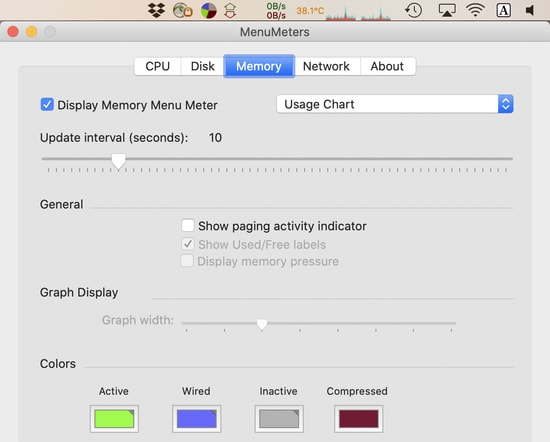

To do that, power down then hit the power button again to boot up you MacBook. Sometimes they encounter issues and require resetting. NVRAM (non-volatile random-access memory) and PRAM (Parameter RAM) are small memory partitions that store settings like volume control and display resolution. If that doesn't work, it's time to start turning to more technical solutions. After it's completely booted up, you can restart again in normal startup and see if the black screen is fixed. Sometimes you may be asked to login twice, and your computer may take a longer than usual to start while it carries out diagnostics. You should see 'Safe Boot' in the upper right corner of the window. Release the Shift key when the login window appears. Turn it on again and immediately hold down the Shift key.
TEMP MONITOR MACOS PRO
To boot into Safe Mode, power off and let your MacBook Pro sit for 20 seconds. This can eliminate the potential for issues with other apps and services interfering and preventing your screen from displaying correctly. MacBook Pro Safe Mode allows you to start you MacBook without other launch agents booting up. We have no idea why this works, but plenty of people have vouched for it. Wait 15 seconds and press the button to restart. Press power button once, Press 'S' (the sleep hotkey), and then hold the power button to perform a hard shut down. This isn't official from Apple, but years of MacBook lore claim that a particular key sequence can sometimes revive a non-reacting blank MacBook Pro screen. If it finds no errors, Apple recommends reinstalling macOS. If Disk Utility finds errors and repair them, restart your MacBook again afterwards. In both cases, if this recovers your screen, it's worth running Disk Utility to check for errors. If you still see a blank screen after about 20 seconds, it's time to move on. On an older Intel-chipped MacBook Pro, press and hold the power button for about 10 seconds, then press and release the power button and immediately press and hold Command + R until you see an Apple logo or other image. If the startup options window doesn't appear, release the power button and try again. If the options window doesn't appeal, release the power button, and press and hold it again for another 10 seconds. You should see the startup options window, which includes a gear icon labelled Options. On an Apple-chipped MacBook Pro (from the M1 MacBook Pro 13 to the new 2023 M2 Pro and M2 Max models), press and hold the power button for about 10 seconds. Sometimes a good old-fashioned hard restart is all it takes to fix all kinds of MacBook issues. Still no luck? Then try a forced reset and then start up from macOS Recovery. Once you're screen is back, it's worth running Disk Utility to repair any errors (Image credit: Apple / Future) If you definitely have power, but your MacBook isn't starting up, make sure it's disconnected from anything other than your charging cable and adapter. Peripheral devices like printers, keyboards, external drives, mice and trackpads can all cause potential start up problems. Hit F2 or use the control bar to try increasing the brightness on your MacBook Pro. It’s also possible that you (or your cat) might have unintentionally hit the brightness keys on the keyboard at some point at that you screen is simply dimmed. Check the power indicator light shows so you can rule out a faulty power cable.

If you're running on battery, connect your laptop to its charger just in case the battery has run down.


It can be a massive relief to discover the issue is something as simple as this. This might seem obvious and you've probably already done it, but just to be sure, do check the power and brightness controls. These are the steps we've been through to try to solve the problem, whether it involves the laptop's own screen or an external display. Many of our writers and creative contributors use MacBooks for their daily work, so a black screen on MacBook Pro is an issue we've come across more than a few times. Before you start fretting about repair bills at your nearest Apple Authorised Service Provider or store, try working through the steps below. However, If you've waited and are still seeing a MacBook Pro black screen (or MacBook Air black screen) after a few minutes, it's time to try to solve the issue. This can be unnerving, but if you sit it out, the laptop might start up normally. You'll normally see a black screen on MacBook Pro (or a grey or blue screen) at least once during startup, and sometimes the startup process can take longer than others, especially if it's been a while since you've used your device. MacBook Pro black screens can occur in several forms, and the good news is that it's often not a major cause for concern.


 0 kommentar(er)
0 kommentar(er)
